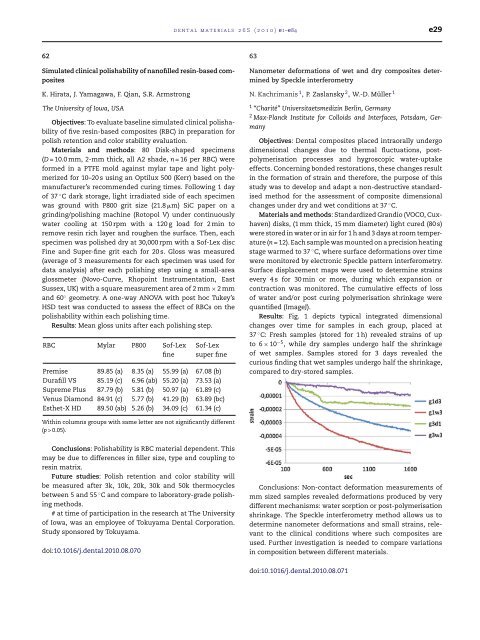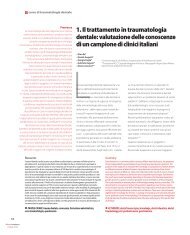Abstracts of the Academy of Dental Materials Annual ... - IsiRed
Abstracts of the Academy of Dental Materials Annual ... - IsiRed
Abstracts of the Academy of Dental Materials Annual ... - IsiRed
Create successful ePaper yourself
Turn your PDF publications into a flip-book with our unique Google optimized e-Paper software.
62<br />
Simulated clinical polishability <strong>of</strong> nan<strong>of</strong>illed resin-based composites<br />
K. Hirata, J. Yamagawa, F. Qian, S.R. Armstrong<br />
The University <strong>of</strong> Iowa, USA<br />
Objectives: To evaluate baseline simulated clinical polishability<br />
<strong>of</strong> five resin-based composites (RBC) in preparation for<br />
polish retention and color stability evaluation.<br />
<strong>Materials</strong> and methods: 80 Disk-shaped specimens<br />
(D = 10.0 mm, 2-mm thick, all A2 shade, n = 16 per RBC) were<br />
formed in a PTFE mold against mylar tape and light polymerized<br />
for 10–20 s using an Optilux 500 (Kerr) based on <strong>the</strong><br />
manufacturer’s recommended curing times. Following 1 day<br />
<strong>of</strong> 37 ◦ C dark storage, light irradiated side <strong>of</strong> each specimen<br />
was ground with P800 grit size (21.8 �m) SiC paper on a<br />
grinding/polishing machine (Rotopol V) under continuously<br />
water cooling at 150 rpm with a 120 g load for 2 min to<br />
remove resin rich layer and roughen <strong>the</strong> surface. Then, each<br />
specimen was polished dry at 30,000 rpm with a S<strong>of</strong>-Lex disc<br />
Fine and Super-fine grit each for 20 s. Gloss was measured<br />
(average <strong>of</strong> 3 measurements for each specimen was used for<br />
data analysis) after each polishing step using a small-area<br />
glossmeter (Novo-Curve, Rhopoint Instrumentation, East<br />
Sussex, UK) with a square measurement area <strong>of</strong> 2 mm × 2mm<br />
and 60 ◦ geometry. A one-way ANOVA with post hoc Tukey’s<br />
HSD test was conducted to assess <strong>the</strong> effect <strong>of</strong> RBCs on <strong>the</strong><br />
polishability within each polishing time.<br />
Results: Mean gloss units after each polishing step.<br />
RBC Mylar P800 S<strong>of</strong>-Lex<br />
fine<br />
dental materials 26S (2010) e1–e84 e29<br />
S<strong>of</strong>-Lex<br />
super fine<br />
Premise 89.85 (a) 8.35 (a) 55.99 (a) 67.08 (b)<br />
Durafill VS 85.19 (c) 6.96 (ab) 55.20 (a) 73.53 (a)<br />
Supreme Plus 87.79 (b) 5.81 (b) 50.97 (a) 61.89 (c)<br />
Venus Diamond 84.91 (c) 5.77 (b) 41.29 (b) 63.89 (bc)<br />
Es<strong>the</strong>t-X HD 89.50 (ab) 5.26 (b) 34.09 (c) 61.34 (c)<br />
Within columns groups with same letter are not significantly different<br />
(p > 0.05).<br />
Conclusions: Polishability is RBC material dependent. This<br />
may be due to differences in filler size, type and coupling to<br />
resin matrix.<br />
Future studies: Polish retention and color stability will<br />
be measured after 3k, 10k, 20k, 30k and 50k <strong>the</strong>rmocycles<br />
between 5 and 55 ◦ C and compare to laboratory-grade polishing<br />
methods.<br />
# at time <strong>of</strong> participation in <strong>the</strong> research at The University<br />
<strong>of</strong> Iowa, was an employee <strong>of</strong> Tokuyama <strong>Dental</strong> Corporation.<br />
Study sponsored by Tokuyama.<br />
doi:10.1016/j.dental.2010.08.070<br />
63<br />
Nanometer deformations <strong>of</strong> wet and dry composites determined<br />
by Speckle interferometry<br />
N. Kachrimanis 1 , P. Zaslansky 2 , W.-D. Müller 1<br />
1 “Charité” Universitaetsmedizin Berlin, Germany<br />
2 Max-Planck Institute for Colloids and Interfaces, Potsdam, Germany<br />
Objectives: <strong>Dental</strong> composites placed intraorally undergo<br />
dimensional changes due to <strong>the</strong>rmal fluctuations, postpolymerisation<br />
processes and hygroscopic water-uptake<br />
effects. Concerning bonded restorations, <strong>the</strong>se changes result<br />
in <strong>the</strong> formation <strong>of</strong> strain and <strong>the</strong>refore, <strong>the</strong> purpose <strong>of</strong> this<br />
study was to develop and adapt a non-destructive standardised<br />
method for <strong>the</strong> assessment <strong>of</strong> composite dimensional<br />
changes under dry and wet conditions at 37 ◦ C.<br />
<strong>Materials</strong> and methods: Standardized Grandio (VOCO, Cuxhaven)<br />
disks, (1 mm thick, 15 mm diameter) light cured (80 s)<br />
were stored in water or in air for 1 h and 3 days at room temperature<br />
(n = 12). Each sample was mounted on a precision heating<br />
stage warmed to 37 ◦ C, where surface deformations over time<br />
were monitored by electronic Speckle pattern interferometry.<br />
Surface displacement maps were used to determine strains<br />
every 4 s for 30 min or more, during which expansion or<br />
contraction was monitored. The cumulative effects <strong>of</strong> loss<br />
<strong>of</strong> water and/or post curing polymerisation shrinkage were<br />
quantified (ImageJ).<br />
Results: Fig. 1 depicts typical integrated dimensional<br />
changes over time for samples in each group, placed at<br />
37 ◦ C: Fresh samples (stored for 1 h) revealed strains <strong>of</strong> up<br />
to 6 × 10 −5 , while dry samples undergo half <strong>the</strong> shrinkage<br />
<strong>of</strong> wet samples. Samples stored for 3 days revealed <strong>the</strong><br />
curious finding that wet samples undergo half <strong>the</strong> shrinkage,<br />
compared to dry-stored samples.<br />
Conclusions: Non-contact deformation measurements <strong>of</strong><br />
mm sized samples revealed deformations produced by very<br />
different mechanisms: water sorption or post-polymerisation<br />
shrinkage. The Speckle interferometry method allows us to<br />
determine nanometer deformations and small strains, relevant<br />
to <strong>the</strong> clinical conditions where such composites are<br />
used. Fur<strong>the</strong>r investigation is needed to compare variations<br />
in composition between different materials.<br />
doi:10.1016/j.dental.2010.08.071



